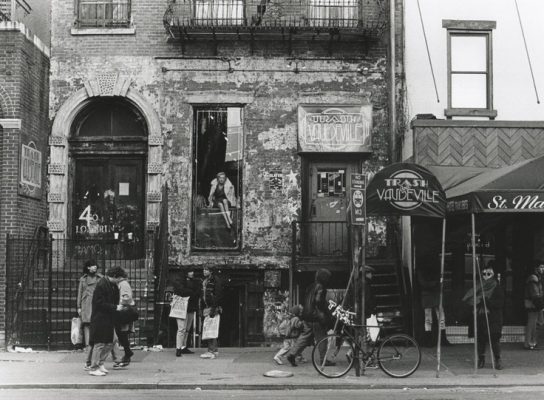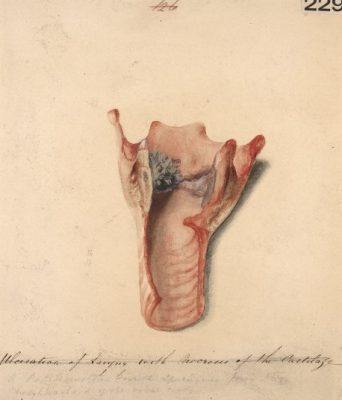Acker by Kraus is a tantalising prospect. How do you go about writing a biography of an inveterate self-mythologiser, who made over fiction into life just as she made over life into fiction? How do you do it when her scene – the downtown New York artistic demi-monde of the 1970s and early 1980s – is already so exhaustively storied? And what position do you take as a biographer when your own name is indelibly yoked together with that of your subject?
Kraus herself, quoted in the blurb, prepares us for a certain kind of book: writing about Acker, she says, elicited in her ‘this incredible frisson of feeling that often I could write “I” instead of “she”’. We might expect, then, a matrilineal act of inhabitation, or of Acker-ish ventriloquism – the ‘collisions between I’s’ seen in the novels that Kraus notes as one of Acker’s most powerful experimental effects. The story is told straighter than you expect, but there are touches of that here, moments of close-up exposition where it appears that the biographer has taken up residence inside her subject: ‘she realised that this outpouring might seem a bit strange, but she couldn’t stop’.
Yet Kraus is generally strangely absent – written out, even. We know they moved in the same incestuous circles, shared similar artistic preoccupations and both had significant relationships with the critical theorist Sylvère Lotringer, but Kraus appears in the first-person only once, attending an Acker reading at the Mudd Club in 1980. Fittingly, for this writer who never kept any of her correspondence, and whose ‘greatest strength and weakness… lies in the exclusion of all viewpoints except that of the narrator’, Acker often narrates herself. Large chunks and small slivers of her novels and diaries are welded into the book, distinguished only by italics. But here her correspondents are also allowed to talk back. Kraus gathers and places uneasily side-by-side multiple, often contradictory, accounts from friends, peers and lovers.
It begins after the end, following her death from breast cancer in 1997, as Acker’s friends scatter her ashes. This, writes Kraus, is her ‘establishing shot’, an ‘apocryphal allegory of an artistic life in the late twentieth century’. It makes for a pretty tawdry picture. Acker’s artist and writer peers are thin on the ground – and several who do show can’t help but embarrass themselves, or insist on doing a turn. Kraus then moves on to Acker’s originary myth: a ‘brief and partly self-willed season in hell’ when the then-23-year-old Acker first moved to New York, where she mostly slept, wrote through a hypnogogic fug, and supported herself by performing in a Times Square sex show. At this point, though, she’s already cycled through several iterations of herself: Upper East Side Jewish aspirant Ivy Leaguer, teenage avant-gardista, bookwormish waif and stray, shoplifting, sexually precocious cool girl and San Diego housewife. She’s not yet calling herself a writer, but the book people she meets tell her the sex show sounds ‘wonderful, great’. Her breakthrough comes at a St. Mark’s Place poetry reading, and what follows is pure picaresque.
Literary history tends to make outliers of writers like Acker – and no doubt she had her own interests in appearing sui generis. But the book brilliantly details the heady, endlessly cross-pollinating artistic scene from which Acker emerged. Her writing life, curtailed as it was, cut a path across the late twentieth century, between the tail-end of the Beats and the beginnings of Alt Lit. The poet David Antin’s hastily-concocted undergrad writing workshop exercise – ‘go to the library and steal’ – gave her a writing strategy. Mail art provided her with her first proper readership. Contemporary dance brought her to her body. From phenomenology she drew a theoretical scaffold for a way of seeing the world she’d already intuited, from conceptual art, a method. In French writers like Georges Bataille and Pauline Réage, she found a tradition concerned with the pursuit of experience to its friable limits, in San Francisco’s BDSM scene, a way of practicing the same in life. ‘S&M doesn’t go beyond the bed’, she writes, ‘unlike the usual relationships where it’s all S&M outside the bed.’
Acker knew everybody – and she managed to piss off a good deal of them too, through overweening ambition and artistic subterfuge, or else stealing their boyfriends and outstaying her welcome as a houseguest. Relating an anecdote about a 3 a.m. bust-up between Acker’s poet friends, Kraus issues the caveat that this is just an ‘arcane piece of gossip’, but she must know that the tattle here is difficult to resist. One of the stories this biography tells is of a restless and ill-fated search for a like-minded artistic community. Acker would flee New York for Seattle, or San Diego, or San Francisco, or London – she also bought a house in Brighton she never visited – only to find herself ‘bored in the boonies’ and itching to come back. Even late on, in London, as a literary sensation dressed in head-to-toe Comme des Garçons and with her own South Bank Show special, she was still prospecting for potential writer pals via the small ads.
Another is about Acker’s discipline, her control. Against the old claims about the off-the-wrist artlessness of her work, Kraus – whose own I Love Dick was disparaged by one review as ‘a book not so much written as secreted’ – insists that cool conceptualism and sticky expressiveness are of a piece. Acker’s works, she writes, involve ‘accessing fleshy, emotive fragments of female experience within a framework of formalist rigour’. She was prodigiously productive, too. However chaotic her life became, she maintained her ‘regime’, setting up her ‘Don’t Disturb Me – I’m Writing’ sign wherever she found herself and turning out the pages.
Kraus has signalled elsewhere that she’s not in the business of myth-busting. But at certain points she intervenes, both in service to the myths and also to debunk them. Following Acker’s death ‘almost all of the memorial tributes and essays… by her friends speak of her “vulnerability”’. In one of several accounts included here the artist Leslie Dick speaks of ‘recognising the spectacle’ of Acker’s peroxide crop and kohl-rimmed eyes ‘as a mask that she peered out from behind, or within, oddly like a little girl’. But Kraus has no truck with these attempts to replace one myth with another; to position the famously fierce and swashbuckling self-invented ‘Great Writer as Countercultural Hero’ as a ruse concocted to compensate for a hidden, more authentic self that was timid and frail. It is not surprising that she would step in here, given that her own work powerfully demands new, more expansive definitions and interpretations of states of fragility and exposure as well as of identity. Acker’s vulnerability, she writes, was ‘highly strategic’ and to ‘pretend otherwise is to discount the crazed courage and breadth of her work’.
One of the myths the book does unpick has to do with the financial realities of making a living as an artist. Clearly Acker worked, but she didn’t work. Born into Upper East Side affluence, Acker chose to affiliate herself with precariousness and picturesque artistic squalor until she came into family money at the end of the 1970s. Kraus keeps a close eye on the bottom line, recording the grants and advances Acker received, querying her claim to have lived on the $15 per week she earned as then-boyfriend Peter Gordon’s ‘live-in maid’. By making visible the financial scaffold that enables artistic work – almost always glossed over in accounts of artists’ lives – Kraus challenges older ideas about the ethics of self-fashioning and self-presentation with newer ones about privilege, identity and appropriation. That said, when she tries to make a link between Acker claiming social security and New York’s ‘catastrophic municipal debt’ this feels a little over-egged.
In what could be a wry, self-conscious gag, early on Kraus appears to elaborate a quote from Dodie Bellamy’s essay ‘Digging Through Kathy Acker’s Stuff’. Of the childhood experiences of loss, rejection and abandonment Acker works over and over in her writing Kraus has Bellamy ask: ‘Was it true? Did it matter?’ Kraus won’t quite be drawn on the first, but the answer to the second is ‘yes’. For Acker, self-invention is a political act. Each new version of self manifests the conditions of its own possibility, begs the question posed in the epigraph to I Dreamt I Was a Nymphomaniac: ‘But what would the world have to be like for these events to exist?’ Self-making is world-making. Early on in the book, Kraus appears to concur: ‘didn’t she do what all writers must do? Create a position from which to write?’ Acker’s claims to have sat at the feet of mentors she had never met are justifiable as attempts ‘to position her work within an intellectual history where it rightly belonged’. However, as the book goes on she becomes less sympathetic. Towards the end, Acker’s self-fashioning has become autobiographic ‘enhancement’ or ‘fictionalisation’, her image a ‘trap partly of her own devising’.
Kraus has said that she intends After Kathy Acker to be a ‘hologram’ rather than an exposé, but the effect is less the revivification of her subject as greater than the sum of her contradictions and more a sense of deep and abiding ambivalence – and not always by design. Still, Kraus has always insisted (and, yes, she’s had to) that the narration of female consciousness didn’t begin with I Love Dick, that she wasn’t the first to write female desire as a roving, tentacular presence, or to render states of romantic abjection and self-abasement – to expose, in short, what Emily Gould has called ‘the problem of heterosexuality’. Her twenty-year-old book has lately floated from the margins to the centre of the culture, and with this biography, she’s directing the attention of a broad, new generation of readers to her close predecessor and peer. At one point, she writes that Acker was a ‘time traveler, smuggling avant-garde histories into the media culture of the 1980s’. We might say that Kraus is doing the same for our own decade.




